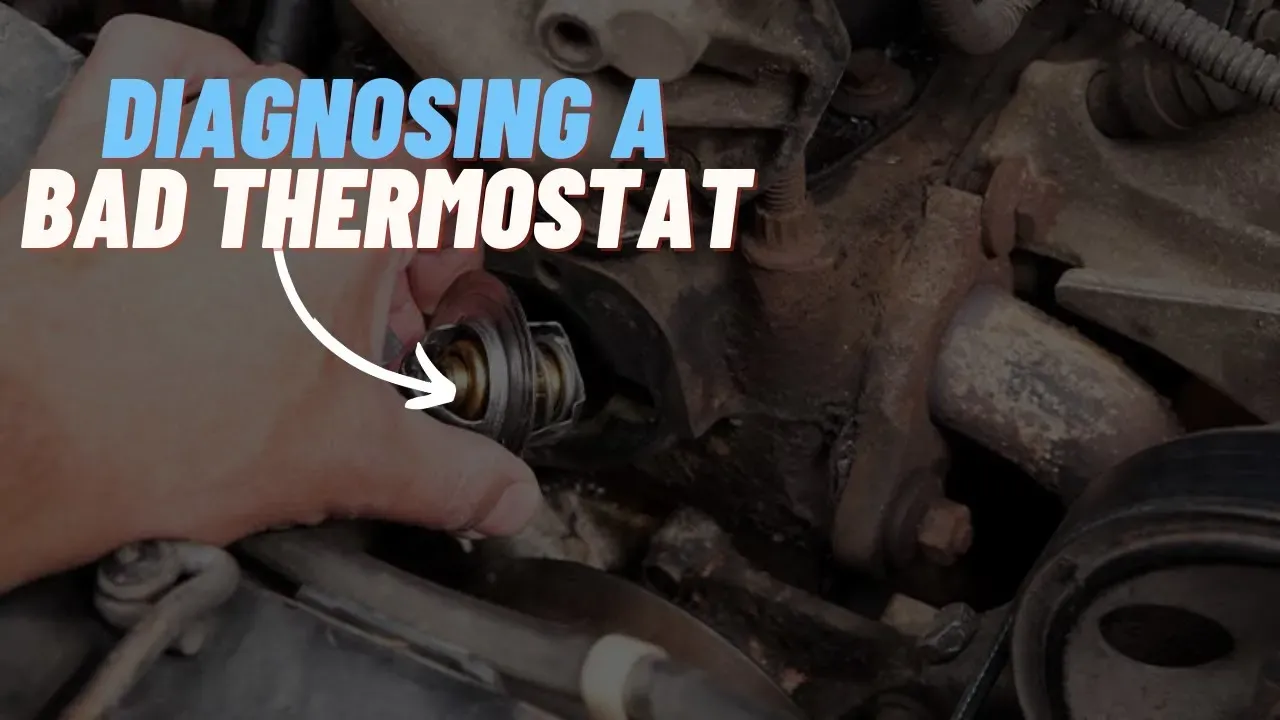Diesel engine thermostat signs are crucial indicators that your vehicle’s cooling system may be malfunctioning. A properly functioning thermostat ensures that your engine maintains the optimal temperature, preventing issues such as diesel engine overheating. If you notice bad thermostat symptoms like an erratic engine temperature gauge or coolant leaks, it’s vital to address these concerns promptly. Additionally, when your car cabin heating experiences issues, it could be linked to a faulty thermostat. Recognizing these signs early can save you from more significant repairs and ensure your diesel engine performs efficiently.
Understanding the signs of a malfunctioning thermostat in your diesel engine is essential for maintaining vehicle performance. Terms like “thermostat failure symptoms” or “engine cooling issues” can help you identify potential problems before they escalate. A defective thermostat can lead to overheating or insufficient cabin heat, both of which can be uncomfortable and dangerous. Recognizing these indicators early on, such as noticing fluctuating engine temperatures or coolant leaks, can prevent costly repairs. By staying informed about these alternative terms and their implications, you can ensure your engine operates smoothly and efficiently.
Signs of a Failing Diesel Engine Thermostat
Recognizing the signs of a failing diesel engine thermostat is crucial for maintaining the health of your vehicle. One of the most common symptoms is an erratic reading from the dashboard temperature gauge. Under normal conditions, the gauge should remain steady, indicating that the engine is operating at an optimal temperature. However, if the gauge fluctuates wildly, it suggests that the thermostat may be malfunctioning. This erratic behavior can lead to serious issues if not addressed promptly, as it can mean the engine is either overheating or running too cold.
Another sign of a malfunctioning thermostat is the complete failure of the engine to reach the appropriate operating temperature. If you notice that your engine takes a long time to warm up or never seems to reach the right temperature, it could be due to a stuck-open thermostat, which prevents the engine from heating properly. This condition can lead to increased fuel consumption as the engine struggles to operate efficiently, further emphasizing the importance of timely diagnosis and repair.
Coolant Leaks: A Key Indicator of Thermostat Issues
Coolant leaks are another critical sign that your diesel engine thermostat may be failing. If you observe puddles of coolant under your vehicle or notice a decrease in coolant levels, it’s essential to investigate further. The thermostat is typically located between the engine and the radiator, and any wear and tear on the gaskets or seals can lead to leaks. Over time, these components degrade, resulting in coolant escaping from the system, which can severely affect your engine’s cooling capabilities.
In addition to the visible signs of coolant leaks, you may also notice crusty or discolored deposits around the radiator and hoses. This buildup often indicates that coolant is seeping from the thermostat housing or nearby connections. Ignoring these symptoms can lead to more severe engine damage and costly repairs down the line, making it imperative to address any leaks as soon as they are detected.
Engine Overheating: The Consequence of a Bad Thermostat
Engine overheating is perhaps the most alarming symptom of a faulty thermostat in a diesel engine. If the thermostat becomes stuck in the closed position, it prevents coolant from circulating through the engine, leading to excessive heat buildup. This can result in serious engine damage if not addressed immediately. Drivers should be particularly vigilant if they notice the temperature gauge creeping into the red zone while driving, as this is a clear sign that the engine is overheating.
Moreover, if you’re experiencing overheating issues, it’s crucial to stop the vehicle as soon as it is safe to do so. Continuing to drive an overheating engine can result in catastrophic failure, such as a blown head gasket or warped cylinder head. Regularly checking the coolant levels and monitoring the temperature gauge can help catch these problems early, but if you suspect a bad thermostat, a professional inspection is highly recommended.
Unusual Noises: A Warning Sign of Thermostat Failure
Hearing strange sounds coming from the engine bay can be concerning, and it often indicates an underlying issue with your diesel engine’s cooling system. If the thermostat is stuck closed, coolant may begin to boil, leading to bubbling or hissing noises as pressure builds up within the system. These sounds can be alarming and should not be ignored, as they suggest that the engine is overheating and could sustain damage if not addressed.
Additionally, you may notice steam escaping from under the hood if the coolant is boiling over due to excessive heat. This scenario can pose a serious safety risk, not only to the vehicle but also to the driver and passengers. If you experience such noises, it is advisable to pull over immediately and have the vehicle inspected by a qualified technician to prevent further damage.
Impact on Cabin Heating: A Sign of Thermostat Malfunction
One often overlooked symptom of a failing diesel engine thermostat is the impact on the vehicle’s cabin heating system. The thermostat plays a vital role in controlling the flow of hot coolant to the heater core, which is responsible for warming the air that circulates into the cabin. If the thermostat is stuck in the open position, the coolant may not reach the heater core effectively, resulting in insufficient heating within the vehicle.
Conversely, if the thermostat is stuck closed, the engine may overheat, which can also affect cabin heat output. In either case, drivers may find themselves unable to maintain a comfortable temperature inside the vehicle, especially during colder months. Addressing thermostat issues promptly can help restore proper cabin heating functionality and ensure a more pleasant driving experience.
Monitoring Engine Temperature: Key to Preventing Thermostat Issues
Monitoring the engine temperature is essential for any diesel vehicle owner, as it provides critical insights into the health of the engine and the cooling system. The engine temperature gauge on the dashboard is your first line of defense against overheating and potential thermostat failure. Regularly checking this gauge can help you catch any irregularities early on, such as the gauge fluctuating unexpectedly or remaining too low.
In addition to visual inspections, it’s advisable to keep an eye out for any changes in engine performance, such as decreased power or unusual noises. If you notice any of these symptoms alongside erratic temperature readings, it may indicate a malfunctioning thermostat that requires immediate attention. Staying proactive about monitoring engine temperature can save you time and money by preventing more extensive damage down the road.
Preventive Maintenance for Your Diesel Engine’s Thermostat
Preventive maintenance is key to ensuring the longevity and efficiency of your diesel engine’s thermostat. Regularly scheduled maintenance checks can help identify any potential thermostat issues before they escalate into more significant problems. This includes inspecting the thermostat during routine coolant changes or engine inspections, ensuring that it is functioning correctly and that there are no leaks in the system.
Additionally, keeping an eye on coolant levels and quality is essential for optimal performance. Old or contaminated coolant can lead to clogs or corrosion within the cooling system, affecting the thermostat’s functionality. By prioritizing maintenance and addressing any signs of thermostat failure early on, you can help prevent unnecessary repairs and keep your diesel engine running smoothly.
Understanding the Role of the Thermostat in Engine Performance
The thermostat plays a crucial role in maintaining optimal engine performance by regulating the flow of coolant throughout the cooling system. It ensures that the engine reaches its ideal operating temperature, which is vital for efficient fuel combustion and overall performance. A malfunctioning thermostat can lead to either overheating or underheating, both of which can adversely affect engine efficiency and longevity.
Furthermore, understanding the role of the thermostat in your diesel engine’s cooling system can help you recognize the symptoms of failure sooner. As the thermostat controls the flow of coolant based on engine temperature, any erratic behavior or failure to open and close properly can lead to significant issues, including loss of power and increased fuel consumption. Awareness of these factors can empower vehicle owners to take preventive measures and seek professional help when necessary.
The Importance of Professional Inspections for Thermostat Issues
When it comes to diagnosing and repairing thermostat issues in diesel engines, professional inspections are invaluable. While some symptoms may seem minor, they can indicate underlying problems that require expert attention. Technicians have the knowledge and tools to perform thorough diagnostics, ensuring that any thermostat malfunction is identified and addressed promptly before it leads to more severe engine damage.
Additionally, professional inspections can provide peace of mind, as trained technicians can recommend the best course of action based on the specific issues detected. This proactive approach not only helps maintain engine health but can also save vehicle owners from expensive repairs in the future. If you suspect thermostat issues, scheduling a professional inspection can be a wise investment in your diesel engine’s longevity.
Frequently Asked Questions
What are the common diesel engine thermostat signs to look for?
Common diesel engine thermostat signs include an erratic engine temperature gauge, coolant leaks, cabin heating issues, strange sounds from the engine bay, and overheating of the engine. These symptoms indicate potential thermostat failure.
How can a bad thermostat affect my diesel engine’s temperature gauge?
A bad thermostat can cause the engine temperature gauge to move erratically. This happens when the thermostat becomes stuck in an open or closed position, disrupting the normal flow of coolant and leading to inaccurate temperature readings.
What are the symptoms of diesel engine overheating related to the thermostat?
Symptoms of diesel engine overheating related to the thermostat include the engine temperature gauge rising above normal levels, steam coming from under the hood, and the engine warning light illuminating. These signs indicate that the thermostat may be malfunctioning and not regulating coolant flow properly.
What should I do if I notice coolant leaks in my diesel engine?
If you notice coolant leaks in your diesel engine, it is crucial to inspect the thermostat and its seals immediately. Coolant leaks often suggest a failing thermostat gasket or housing, which can lead to overheating and other serious engine issues.
How does a faulty thermostat affect my car’s cabin heating system?
A faulty thermostat can cause the cabin heating system to stop working effectively. If the thermostat is stuck open, the engine may not reach the proper temperature, resulting in cold air blowing into the cabin. Conversely, if it’s stuck closed, it can lead to overheating, further complicating heating system performance.
| Sign | Description |
|---|---|
| Erratic Dashboard Temperature Gauge | The temperature gauge fluctuates unexpectedly, indicating a malfunctioning thermostat. |
| Coolant Leaks | Puddles of coolant under the vehicle may signify a failing thermostat gasket. |
| Cabin Heating System Failure | Inadequate heating in the vehicle’s cabin may occur if the thermostat is stuck. |
| Strange Noises from Engine Bay | Bubbling or hissing sounds can indicate boiling coolant due to a thermostat issue. |
| Car Overheating | Overheating can result from a defective thermostat, leading to coolant flow issues. |
Summary
Diesel engine thermostat signs are crucial indicators of potential issues within your engine’s cooling system. Recognizing these signs early can help mitigate risks of severe engine damage. Common symptoms include erratic temperature readings, coolant leaks, cabin heating system failures, unusual sounds from the engine bay, and overall overheating. Prompt attention to these symptoms can ensure your diesel engine operates efficiently and reliably.










